
Responsible, sustainable beef production
DISCLAIMER
The product trade names in this publication are supplied on the understanding that no preference between equivalent products is intended and that the inclusion of a product does not imply endorsement by NSW Department of Primary Industries over any other equivalent product from another manufacturer.
Introduction
Grazing industries are generally considered to be more benign than cropping systems in terms of their effect on the environment. However, beef production does impact upon plants, soil, air and water, and depletes resources such as fuel. Environmental management in grazing beef production is therefore just as important to the future of the industry and its individual producers as is product quality and consistency, profitability and market access.
Colonists arriving in Australia in the 1800s traditionally set out to ‘conquer’ or ‘tame’ the land, and applied European methods of farming in doing so. We now realise that this path is not sustainable. Producers must work with the land and its climate, within its limitations.
Management issues for today’s beef producer
Beef production in Australia today is a complex business. The European methods of farming that were initially introduced to this country have had to be modified to allow for the unreliable nature of Australia’s climate, and its very different soils and vegetation. Market forces have changed considerably in the last couple of decades, and consumers now demand natural food which is free of chemicals and is produced without detriment to the environment or to the welfare of animals.
Beef producers need to have a wide understanding of many factors if they wish to build and maintain a successful, sustainable business:
- sustainable pasture management;
- maintenance of biodiversity;
- soil management;
- water management;
- minimisation of greenhouse gas emissions;
- minimisation of offensive odours and dust;
- efficient use of other resources such as fuel;
- good stock management, taking animal welfare into consideration;
- responsible use of chemicals;
- property management planning, including good risk management, with enterprise flexibility which enables adaptation to changing markets;
- good monitoring and recording systems which gather useful information about the enterprise and allow assessment of financial and environmental sustainability;
- good community relationships and perceptions.
- air management:
Sustainable pasture management
The way in which animals graze can make or break a pasture. Cattle producers have traditionally put the needs of their stock first. However, in hard times when the requirements of animals and plants may be in conflict, the plants’ requirements must not be forgotten. Perennial grasses must not be sacrificed because of short-term desperation.
In drought conditions, it may be necessary to start hand feeding or to destock sooner than is considered necessary to maintain the stock, in order to ensure pasture survival, and speed recovery when useful rain falls. (For further information on managing pasture in drought, visit DroughtHub section of the website.)
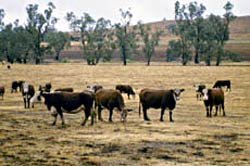
The growth of pasture may be divided into three phases:
- Phase I: Pasture is very short (<3 cm) and root reserves are usually low. The small leaf area limits the amount of energy that plants can obtain from the sun, so growth is slow.
- Phase II: there is enough leaf for plants to grow rapidly.
- Phase III: growth slows down and quality falls as the plants mature and set seed.
The shorter the pasture, the longer it will stay in phase I when conditions improve. It is false economy to delay the start of hand feeding at the beginning of a drought, as this just means that your ‘green drought’ phase will last longer when useful rain finally falls.
In a normal season, keeping the pasture in its active growth phase (phase II) will maximise both pasture and animal production. At some stage, however, the pasture must be rested to allow it to mature and set seed, even though its quality will fall as a result.
There may be other reasons why grazing pressure is increased or decreased at specific times — for example, heavy grazing when an undesirable species is setting seed, in order to control its spread.
Continuous stocking of pastures can rarely be recommended. Some form of controlled grazing that includes periods of spelling that are timed to coincide with specific needs of the pasture is critical to productive, stable systems.
Effective nutritional management of the herd relies on the establishment of productive stable pastures that preferably contain at least 30% of a well-adapted legume. Where possible, and depending on the enterprise and market targets, properties should have a mix of pasture types (both native and introduced) to increase the options for grazing management.
In poor seasons, native pasture (being better adapted to Australia’s unreliable rainfall and poor soils) may produce more useful feed than will introduced species, which give greater production in good seasons.
Using grazing management to maintain or improve pasture quality has a distinct advantage over other management methods — it can cost almost nothing. If grazing management is not practised or is inadequate, more expensive inputs such as fertiliser and herbicides, and more frequent resowing of pasture, are likely to be required.
Effects of stocking rate on pasture
There is no static optimum stocking rate, as carrying capacity of a property varies from season to season and from one year to the next. Ideally, property stocking rates should reflect variation in carrying capacity through the timing of operations such as calving and sales, and in enterprise flexibility. Management’s values and attitude to risk will of course influence the approach.
There are usually higher returns per cow when stocking rates are low, but there are higher returns per hectare with higher stocking rates. At excessive stocking rates, the system may crash.
If a genetic improvement program or change of breed increases the weight of breeders in the herd, the need to alter stocking density or rotation length must be recognised. For example, 100 Charolais cross cows may eat 20% more than 100 British bred cows, and so will run out of feed sooner if no adjustments are made.
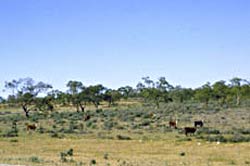
Stocking rate as applied at the paddock level, often called stocking density, is a very powerful pasture management tool. It can be used to actively control the quality and quantity of feed on offer and the survival of desirable or undesirable plant species. For example, high-density grazing with dry stock might be used to remove bulky dead pasture in order to prevent shading of new pasture growth. (Protein supplements for the cattle may be needed to encourage more complete use of low quality dry forage, but close monitoring is necessary to prevent overgrazing. See the section ‘Maintaining ground cover’.)
Both low and high stocking rates have the potential to substantially alter pasture composition. Different plant species will respond differently to grazing pressure. Annual grasses tend to be more competitive, and they germinate and grow faster than do perennial species. Thus if high stocking rates are maintained for too long a period, overgrazing may allow annuals to dominate and displace perennials, resulting in a shortage of forage outside the annuals’ growing season.
It also needs to be recognised that if the overall quality of the pasture is not high, animal production will suffer if stocking rate is increased to the point where selection of the higher quality pasture components is no longer possible. On the other hand, at low stocking densities, the opportunity to select the higher quality component of the pasture may maximise animal production, but the effect over time may be to allow the less desirable ungrazed plants to dominate. If stocking rate is not adjusted, the more desirable species may be lost, and the quality of the pasture overall will fall.
Successful/sustainable grazing management requires skill and experience. The key is flexibility — the rest period or rotation length needs to be adjusted depending on pasture growth rate and seasonal conditions.
Mixed farming gives greater productivity and flexibility
Pastures, particularly perennial pastures, are becoming a vital part of many cropping rotation systems, in addition to their traditional use in country that is too marginal for cropping to be successful. We now recognise that continuous cropping of the same area is detrimental to soil structure, reduces soil organic matter and biodiversity, and is likely to be unsustainable unless there are extensive fertiliser inputs.
Enterprise diversification and the maintenance of biodiversity are becoming increasingly recognised as beneficial for the continuation of successful farming operations, partly because they allow for greater flexibility and therefore some protection from climatic and economic variability.
Systems that combine grazing and cropping enterprises more readily allow the retention of stands of natural vegetation. Undisturbed areas of natural bushland or planted trees become a habitat for wildlife, including insectivorous birds which feed on pests such as aphids, midges, scarab beetles and heliothis caterpillars, and which provide the potential for reducing the need for chemical applications if given the opportunity to multiply adjacent to cropping lands. These undisturbed areas also allow the survival of earthworms and the microflora and microfauna that may otherwise be destroyed in a continuous cropping system.
Pasture rotation can also interrupt the life cycles of annual weeds and other crop pests. If a legume such as lucerne is used, it can build soil nitrogen, which will reduce the need for external fertiliser inputs. Comparing the texture and composition of undisturbed soil with the soil properties of adjacent cropping country may be a valuable indicator as to whether cropping is damaging the soil.
Perennial pasture is a lower-cost and lower-risk operation than enterprises which involve cropping, especially in areas with unreliable rainfall. Benefits include:
- maintenance of ground cover, resulting in less erosion;
- undisturbed soil, providing a habitat for the huge range of microflora and microfauna necessary for healthy soil;
- lower fuel costs than those for a cropping enterprise, which may become a more significant consideration in the future (see the section ‘Minimising fuel consumption’ below);
- greater water extraction from deeper soil layers, which will better combat rising watertables and resultant salinity problems.
Soil management
Avoiding soil compaction
Soil compaction, or ‘soil pugging’, due to the impact of cattle hooves, is inevitable with cattle production. The extreme example of soil pugging is obvious, but the effect of cattle simply treading on the plants and soil is often not appreciated. In experimental trials, using typical commercial stocking rates, yield reductions of at least 20% have resulted.
Compaction severity varies with soil type, being worst on wet soil that has a high clay content. Every effort should be made to move cattle onto lighter soil when heavy rain is likely. Soil compaction results in resistance to root penetration, reduced water infiltration and reduced aeration.
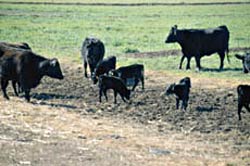
In contrast, where there are sandier soil types and/or in more arid environments, ‘hoof cultivation’ can be invaluable for burying seeds and so helping to establish and renovate pastures.
If cattle are creating tracks, such as the route to the water trough, bear in mind that these can become channels for surface water flow, and may initiate more serious erosion. If this starts to occur, steps will need to be taken to prevent it. Rotational grazing practices are likely to be the best practical means of limiting treading damage.
In mixed-farming enterprises, it is common practice to graze cattle on sorghum stubble following harvest. However, the compaction that results on cropping country is likely to be more damaging than that which results on established pasture, and will reduce the ability to apply the more sustainable farming practices of reduced or ‘no till’ cropping. These factors should be considered in the ‘whole farm’ plan. Further research is required to determine the best system in this situation.
Maintaining ground cover
The amount of ground cover needed to prevent erosion varies with soil type, soil condition, location and slope. For example, research has shown that, on the northern slopes of NSW, a ground cover of at least 70% is needed on red soils where there is a slope of approximately 10%. The figure of 70% ground cover is often used as a good generalisation; however, less cover may be adequate in plains country and more cover may be necessary on steeper ground.
Once run-off becomes excessive, less water soaks into the soil where it is needed, and pasture growth can be far below its potential as a result. Excessive run-off will create erosion problems.
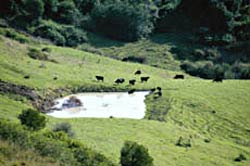
Overgrazing occurs commonly over much of Australia because rainfall and therefore feed supplies are often erratic. These periods of short supply are a normal part of the cycle, so producers should either plan ahead by setting aside feed reserves to carry them through these times, or be willing to destock.
Supplementary feeding should start before ground cover is adversely affected and before stock start to lose condition, otherwise pasture growth rates will be affected. Protein or urea supplements for the cattle will allow more complete use of poor quality paddock feed, but these can encourage serious overgrazing (to the point where cattle eat every blade of grass in the paddock) if pasture levels are not monitored and grazing pressure is not managed properly.
Once ground cover is getting down to levels where there is an increased risk of erosion, animals should be removed by sale or agistment, or confined and fed a complete ration. Animals should not be allowed to continue to wander in search of scarce feed. This wastes the animals’ energy, and hence increases the amount of feed required to maintain body weight or condition, as well as increasing the risk of erosion and threatening the survival of pasture.
Fencing layout
Soil type, topography, aspect, pasture type and mob size should be taken into account as much as possible when planning where fencing will be located:
- Traditional ‘square’ paddocks may make management more difficult if more than one soil type, or both sloping and flat ground, are present within the one paddock. For example, some pasture species may survive on southern slopes (which tend to be cooler and wetter) but not on northern slopes in areas marginal for their requirements.
- Different pasture growth rates due to aspect or changing soil types may need to be managed differently.
- Land that has uniform characteristics should be fenced and managed as a unit as far as practicable.
- Several small paddocks allow greater flexibility in grazing management than do fewer larger paddocks.
- In mixed-farming situations, it may be worth constructing temporary electric fencing, which will help to reduce fencing costs.
Yard location
It is essential to consider soil type and drainage when choosing a site for new yards. Heavy clay soils bog up in wet conditions and are slow to dry out. Light sandy soils may allow effluent to percolate down and pollute underground watertables; they also tend to be very dusty in dry conditions. If possible, choose a site that has loamy well-drained soil.
Where cattle are to be confined for prolonged periods, for example during yard weaning, it is preferable to have a layer of clay below the surface to limit movement of effluent into underground watertables.
Water management
Good quality water is perhaps the scarcest resource on this continent, and needs to be utilised as efficiently as possible. Availability of watering points will influence paddock layout, and may limit the amount of subdivision possible on a grazing property. If watering points are too far apart, cattle will overgraze close to water and undergraze the rest of the paddock. Cattle that have to walk long distances to reach water will waste energy and make slower weight gains.
Provide water in troughs or ground tanks rather than allowing free access to watercourses. Cattle using natural streams tend to erode stream banks and foul water, leading to sedimentation and pollution, and possibly algal blooms downstream. If you cannot provide water in troughs, limit access to stream water to the inside of bends, where the erosion potential is less.
Research has shown that even if a watercourse is not fenced, cattle will prefer to drink at a trough if one is provided on their normal route to water. This information is useful, especially if funds are not available for fencing. (Note: Funds are often available for such projects through Landcare groups or government natural resource management programs.)
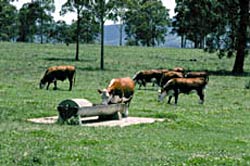
Fenced riparian zone (river bank) areas can be used as a drought reserve, or grazed for short periods in a grazing rotation in order to control weeds. For information on managing stock in riparian zones, see the publication Managing Stock (Issue Sheet 6), which is part of the River Landscapes website, published by Land and Water Australia.
It is also preferable to fence off dams and to pipe dam water to troughs, because cattle will foul dams and reduce water quality, especially when the supply is low. Research has shown that animal performance is affected by foul water, presumably because animals that drink less will also eat less.
Fertiliser run-off
Care must be taken when using fertiliser to ensure that it does not contaminate watercourses. The spreading of fertiliser over or near watercourses or bare sloping country (which may be subject to run-off during intense summer storms) should be avoided.
Air management
Minimising greenhouse gas emissions
Cattle and sheep contribute an estimated 10.8% of Australia’s greenhouse gas emissions, mainly as methane and carbon dioxide. On average, cattle produce an estimated 49 kg methane per head per year.
Methane is produced by microbes in the rumen. This is an undesirable loss to the animal, as it represents a loss of energy, part of the feed that the animal has failed to utilise. The coarser and more fibrous the feed, the greater the proportion of digested energy that is lost as methane. Pasture with high digestibility is more efficiently utilised. (For more information on the digestibility of pasture, see the Primefact Pasture assessment and livestock production.)
Several state and federal research teams are currently attempting to reduce methane production from ruminants by selectively altering the microflora and microfauna of the rumen population. Some reduction in methane production may be possible, but it is unlikely that ruminant emissions will ever be methane-free.
Most beef producers already aim to finish cattle as young as possible, in an attempt to improve meat quality and obtain a better price. An animal that reaches slaughter weight 3 months earlier than others will produce less methane in its lifetime, and hence less methane per kilogram of product. Thus by managing pasture to maintain high digestibility, and by selecting for more feed-efficient cattle and rapid growth, producers are already helping to reduce the greenhouse gases emitted from their herds!
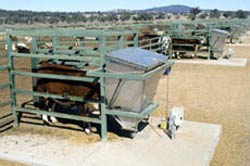
Minimising fuel consumption
The burning of fossil fuels is a major source of greenhouse gases, and this fuel is also a non-renewable resource. The total consumption of resources in producing our food is an increasingly important factor to be considered in the future. Australian pasture-fed beef production is a relatively fuel-efficient system when compared with grain-fed beef production. The fuel costs, including environmental costs, involved in working the soil, sowing seed, and harvesting and transporting the grain are all avoided by raising cattle solely on pasture.
Fuel costs will rise substantially as readily accessible fuel reserves become depleted. The demand for fuel will continue to increase with the expansion of the human population. In the future we may not be able to waste scarce fuel supplies on growing grain for cattle — the energy cost will be too high. We will need to feed all the grain directly to humans.
This long-term view must be kept in mind before any ‘improvements’ involving high fuel usage are contemplated. Introduced pasture in marginal areas may not be economical if frequent re-sowing is necessary. Systems that require the least fuel will be more sustainable in the long term. The value of minimal intervention, perhaps by fertilising existing native pasture, may well come into its own in the next decade.
Stock management
Disease and pest management
Disease control is a normal part of good farm management. Some diseases should be controlled by vaccination, for example leptospirosis and vibriosis. For other diseases where controls are in place for market access, for example Johne’s disease (JD), producers need to take care to abide by legal requirements for trade between different JD zones of the state.
Disease control is essential not only to improve the productivity of your own enterprise, but also to minimise the possibility of adversely affecting your neighbours’ production. Fences should be kept in good order, and bulls in particular should be prevented from straying, to avoid the possibility of disease spread between your stock and your neighbours’ stock. Similarly, feral animals which may spread disease, such as pigs, should be controlled.
Weed control should also be undertaken in order to prevent deterioration of your pasture (and your neighbours’ pastures, to which the seed from your pasture may spread).
Taking responsibility for animal welfare
The Prevention of Cruelty to Animals Act 1979 states that ‘A person in charge of an animal shall not fail to provide food, drink or shelter ...’. It is not acceptable for animal owners to leave the animals in their care to fend for themselves during drought, extreme cold, stress or natural disasters, since in confining their animals they have limited the animals’ ability to take steps to help themselves.
The vast majority of people hold this attitude towards animals in their care. Pressure from the broader community must be brought to bear on the few who do not, and who are bringing the whole industry into disrepute. If you know someone who is allowing animals to starve or is otherwise neglecting the welfare of their animals, say something to them about it. If nothing is done to correct the situation, report it to the RSPCA or police.
Absentee stockowners have had disastrous losses from bloat, because pasture conditions have changed without their knowledge. This is as much a welfare issue as is a lack of feed or water. Arrangements should be made to have cattle and paddock conditions inspected regularly by someone living locally.
Standards and Guidelines
The Australian Animal Welfare Standards and Guidelines for Cattle are available, and these are recommended reading. In many ways, guidelines can be regarded as ‘best practice’ manuals. They can provide useful information; for example, they set out the space required per head of cattle when hand feeding in yards. Guidelines now have some legal standing, in that failure to comply with part of a guideline can be used as evidence, usually in cases involving breaches of the Prevention of Cruelty to Animals Act 1979.
Minimising painful procedures
Animals have a right to be treated humanely and thoughtfully. In the past some painful management procedures have been condoned because there was no practical alternative. This is no longer the case. Producers should be looking for ways of reducing stress and pain in their animals as much as possible.
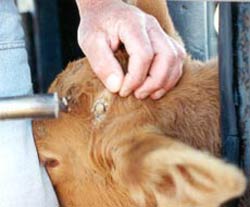 | 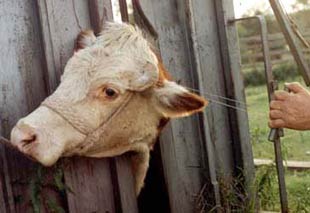 |
Animals have a right to be treated humanely and thoughtfully. In the past some painful management procedures have been condoned because there was no practical alternative. This is no longer the case. Producers should be looking for ways of reducing stress and pain in their animals as much as possible.
It should not be assumed that just because something has always been done a certain way in the past, that it is right! Ask yourself whether the pain and stress that you inflict upon cattle can be reduced. Is the procedure really necessary? Many producers have stopped branding cattle, as the standard of fencing has improved, and alternative methods of identification are becoming more widespread.
In many breeds, polled bulls can be used to eliminate the need to dehorn. If this is not an option, there are several methods of dehorning very young calves which are less traumatic than traditional methods.
Low stress handling
Awareness of the flight zone around cattle is essential to minimise stress. Usually the flight distance is about 2–3 body lengths, but this will vary depending on an animal’s past experience with humans. If this space is invaded, cattle will try to escape. While working cattle in yards, it is best not to invade this space until it is actually required.
Where you stand is critical to where the cattle will move. There is a point of balance, about level with the shoulder, where the animal will move neither forwards nor backwards if approached. If the animal is approached from in front of this point, it will go backwards; if it is approached from slightly behind the shoulder, it will go forwards. For most experienced stockworkers, the use of the point of balance in this way is second nature.
Most producers cull animals that have an aggressive temperament, but it is also important to cull excessively timid, panicky animals. Research has shown that these timid animals (in contrast to aggressive ones) often perform poorly in feedlots. They are also likely to be the ones that use up muscle glycogen and bruise themselves because they panic during loading and transport. This in turn results in dark, poor quality meat.
Aggressive animals may cause bruising in others, or ‘stir up’ during handling, with similar effects on meat quality as those that occur in the panicky cattle.
Consider natural behaviour in yard design
The design of yards, including the way they face in relation to the sun, and the direction of slope, is extremely important. If cattle will not move freely through your yards, have a serious look at the yard design before reaching for the electric prodder!
Natural animal behaviour should be taken into account in the positioning of yards; for example, cattle prefer to run uphill and towards the light. They tend to baulk at dark shadows (see Figure 8). Cattle may work well in the morning but not in the afternoon because of the change in shadow distribution. The timing of husbandry operations may need to be planned accordingly. Including these considerations at the planning stage will make handling easier, and improve stock (and operator) welfare.
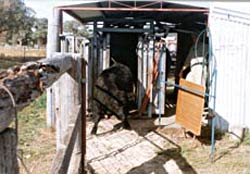
Provision of shade and shelter
In the past, trees have been seen as occupying space and taking up water and nutrients that would otherwise grow more grass to feed more cattle. This attitude has left us with a legacy of rising watertables leading to salinisation of large tracts of land, and increased levels of soil erosion.
The shade and shelter provided by trees and shrubs often more than compensates for the loss of available area for growing grass. An animal’s energy requirements may more than double in cold weather, just to maintain the animal’s body heat. (In general, the smaller the animal, the greater the increase in requirement.) Shelter can reduce this requirement for extra feed by providing a warmer microclimate downwind of the shelter. It also improves the survival rate and welfare of newborn animals during adverse weather conditions.
CSIRO research has shown that during periods of cold stress, shelter increases both temperature and humidity, with the largest increase at a distance of about five windbreak heights from the windbreak, but this extends to a distance of about twelve windbreak heights downwind. That is, a much larger area benefits from the protection than is adversely affected by competition for water and nutrients in the root zone of the windbreak trees.
At the other extreme, cattle in hot climates are likely to have a lower water requirement if they are provided with shade. Provision of shade may maintain soil moisture and extend the period of grazing available from more productive species of pasture plants that have been planted where their rainfall requirements are barely met. Clovers survive for longer in the shade, where they are protected from heat and moisture stress.
Responsible use of chemicals
ALWAYS READ THE LABEL
Users of agricultural (or veterinary) chemical products must always read the label and any Permit before using the product, and strictly comply with the directions on the label and the conditions of any Permit. Users are not absolved from compliance with the directions on the label or the conditions of the Permit by reason of any statement made or not made in this publication.
It is the responsibility of everyone who uses chemicals to ensure that chemical residues do not remain. While zero contamination of produce at all times is an unrealistic expectation, the public often does not distinguish between acceptable residue levels, which are well below those that pose any threat to human health, and unacceptable levels, which are a real concern. To a growing number of consumers, the presence of any chemical whatsoever is perceived as unacceptable, if not unsafe. Whether justified or not, these concerns must be taken seriously, as they can profoundly influence markets. Thus there are two issues involved in the control of residues: safety and quality assurance.
Avoiding residues
When applying any chemicals or other treatments to animals, they should be weighed to ensure that the correct dose is administered. Good records must be kept to show which animals are treated and when they are treated, so that withholding periods (WHPs) can be observed. If cattle are to go for export, then the export slaughter interval (ESI) must also be observed. The ESI may be several times longer than the WHP.
Country that is to be used for grazing cattle should be checked for its previous uses. If persistent chemicals such as organochlorines are suspected to have been used, then soil samples should be sent for analysis. The ground around old dip sites or similar areas should also be sampled or should be fenced off from livestock.
During drought, the risk of unacceptable residues increases. Reasons for this include increased ingestion of contaminated soil when grazing close to the ground, and feeding of unusual feeds, especially if these are not normally fed to stock (e.g. sugar cane, grape mark, and, in the past, cotton trash, which is now not supplied as stockfeed), as these may have had chemicals applied to them.
Any chemical contaminant in feed, if present in sufficient concentration, can cause unacceptable residues in livestock products. When purchasing any feed, the purchaser should inform the seller of the feed’s intended use, and ask if any chemicals have been applied to the feed, or if there may be any other sources of residues. Vendor declarations, such as the one required by the Australian Lot Feeders’ Association, should always be sought. If in doubt, the feed should be either tested or not purchased.
Cattlecare, the beef industry’s on-farm quality assurance system, requires written statements on purchased stockfeeds regarding chemical usage during the production of the feed. (For further information on residue risks in drought, see the Primefact Drought increases residue risks.)
The time taken to clear residues from animal tissues varies greatly, depending on factors such as:
- the chemical involved
- the level of intake
- the duration of feeding
- the changes in the animal’s body weight and condition.
If it is suspected that animals may have been exposed to chemicals, it is preferable to have biopsy samples taken by a veterinarian and tested for residues, rather than risk having the animal(s) condemned at slaughter and placing market access at risk.
Various programs are in place to minimise the risk of residues in meat products. These include:
- NORM - National Organochlorine Residue Management program
- NARM - National Antibacterial Residue Minimisation program.
Unintended victims - dung beetles, other native insects, microflora
While WHPs are designed to avoid unintentional exposure of humans to chemicals, there may be other victims not afforded this protection! There is growing awareness that chemicals we use to control lice and worms in cattle can affect dung beetles and other insects.
Myriad tiny animals contribute to the maintenance of soil fertility and structure. If their numbers are significantly reduced, then soil quality, pasture and therefore animal production are all likely to suffer. Recycling and burying of the nutrients in dung by dung beetles may significantly reduce fly problems in sheep and cattle enterprises, and distributes this natural fertiliser more completely through the soil.
For further information on dung beetles, see the Primefact Dung beetles - working for you.
Antibiotic resistance in humans
There is growing evidence that the use of some antibiotics in animals can lead to the development of resistant strains of the bacteria that can affect humans. The fact that veterinarians are required by law to prescribe S4 drugs only for specific conditions is an attempt to reduce the inappropriate use of antibiotics, and so reduce the risk of resistance developing.
Also of importance is the more immediate threat of the development of resistant animal pathogens. If at all possible, animals should be accurately weighed before they are treated with antibiotics. If only an estimate is made of the weight of an animal, and the estimate is inaccurate, then underdosing or overdosing will occur. Underdosing or not completing the full course of antibiotics may lead to the survival of a few of the most resistant individuals. These will then multiply, and the normal population will become more resistant to the antibiotic used. Many bacteria have the ability to swap genes, thereby conferring resistance to antibiotics with other bacteria. Overdosing may lead to toxicity problems, especially in young animals.
The full course of antibiotics must be completed, even if the animal appears to have already recovered.
The use of low doses of selective antibiotics (e.g. Rumensin®, Lascalocid®, Avoparcin® and Eskalin®, which are used to modify rumen function) is known to increase antibiotic resistance in gut flora. On the other hand, their use leads to greater rumen efficiency, less methane production and faster growth rates, which is environmentally friendly.
Resistance to glycopeptide antibiotics such as vancomycin is becoming more widespread in humans, and there is evidence that this is due at least in part to the use of Avoparcin®, also a glycopeptide, in animal feeds.
Producers must ensure that any antibiotics used for their livestock are absolutely necessary and are given at the correct dose rate, and that WHPs and ESIs are observed.
Property management planning - matching the enterprise to the resources available
Property management planning involves planning the efficient, integrated use of all resources, including human and financial resources as well as the physical resources. It involves the consideration and integration of the many factors that are discussed below. Property management planning is an ongoing process, and it assists producers to improve their profitability and achieve more sustainable natural resource use. Producers and their families should identify their personal and business objectives and then develop plans to achieve those objectives. Monitoring is an important part of this planning process.
More information on property management planning is available through CB Alexander Agricultural College (‘Tocal’), or by contacting your local LLS office.
This Agfact focuses on the responsible use of physical resources. Drawing up a physical farm plan will help with forward planning and clarifying priorities, so that the more important changes are made first. It may be necessary to modify the established layouts of some properties so that environmental factors and animal behaviour can be taken into account, now that these are better understood.
The farm should also be looked at in the context of the surrounding country, and possibly on a total catchment basis. Sometimes, changes to fencing or the position of contour banks, or changes to other aspects of the property, are better planned in conjunction with neighbours. This helps to ensure that what is done on one farm does not adversely affect adjacent property or those further down the catchment. Courses designed to help you draw up a farm plan are available through CB Alexander Agricultural College (‘Tocal’).
The enterprise mix chosen must be matched to the local environment. It may be more cost-effective to change your breed of cattle (or to cross breed) to a type that can effectively use the forage that your land can economically produce, rather than trying to produce feed to support a particular breed of cattle. Some breeds do better than others in tougher environments. For example, larger framed European breeds are harder to support on marginal country or where rainfall is unreliable. On the other hand, it is important to ensure that the cattle–pasture interaction is sustainable. For example, some Bos indicus cattle might overgraze some species of desert plants that Bos taurus cattle would graze only sparingly.
Not all pastures are suited to finishing cattle. You must have a specific market in mind which your cattle and other resources are capable of meeting, so that you can plan ahead to meet the specifications of that market. Long-term survival of an enterprise is unlikely for producers who simply grow out the cattle and then try to find a market which suits them.
Risk management and enterprise flexibility
Farming in the Australian climate is a high-risk enterprise. It is prudent to assume that most years will have less than ideal conditions, and to plan accordingly by conserving fodder to ‘tide you over’. A plan of action in the event of persisting drought conditions should be worked out in advance. Make some rules about which stock would be sold first, and what the trigger would be for this action. (For more information on coping with the adverse conditions caused by drought, see the Drought section of the website.)
It is preferable for there to be flexibility in the type of stock run, so that stock can be finished as vealers, yearling steers or Jap ox, depending on the availability of feed and which markets offer the best returns. Very early or very late maturing cattle tend to limit this flexibility.
Monitoring and record keeping
A good record-keeping system on the farm is essential. Only then will you be able to assess whether your farm plan is working, and whether the enterprise is financially and environmentally sustainable. Often, trends are apparent only when a continuous record over several years has been kept.
Most farmers are familiar with the concepts of keeping records in relation to enterprise productivity and farm finances. However, with the growing awareness of environmental problems and the fragility of the natural resource base, it has become increasingly apparent that the impact of agriculture on the environment should also be monitored in order to assess the sustainability of an agricultural enterprise.
Monitoring financial and productivity performance
Many producers keep a variety of records, then fail to utilise them fully. There are now many excellent computer programs which solve this problem by making calculations easy and enabling much more thorough assessment of productivity and business performance.
Aspects that can be monitored include:
- cows joined, pregnancy test results, and calves born, marked and weaned;
- breeding records, so that poor performers can be identified and culled, and the progeny of different bulls can be compared. (Individual identification of cattle, so that these sorts of records can be kept, is strongly recommended);
- growth rates, so that genetic merit or feeding regimes can be compared;
- cattle numbers bought and sold;
- sale age, weight and price;
- production per hectare (‘total weight of animals sold’ divided by ‘total hectares grazed’);
- meat income per grazing hectare (‘proceeds from animals sold’ divided by ‘total hectares grazed’);
- any health problems in stock, crops and pasture;
- treatments (e.g. antibiotics, and lice and worm treatments), the dates these were administered to animals, any withholding periods (WHPs) or export slaughter intervals (ESIs), and the results of treatment;
- paddock records, pasture growth, ground cover, dates stock went in and out etc.;
- dates of fertiliser or weedicide applications, insecticide sprays etc., and any WHPs;
- all costs, including treatment costs for animals, costs of crops and pasture, sowing costs, machinery maintenance costs, selling costs etc. (Allocate all costs separately to different components of a mixed-farming enterprise so that you can check that each component is paying its way. For example, calculate fuel and machinery costs associated with sowing grazing oats separately from the costs involved with any cropping enterprise, since the grazing oats are part of the cattle enterprise.);
- water use, water quality etc.
Monitoring the condition of natural resources
Obtaining a measure of a farm’s environmental sustainability is not straightforward, but there is some relatively simple monitoring that can be undertaken which will provide you with a guide as to the health of your farm’s natural resources.
With environmental monitoring, it is very important to monitor over a period of time in order to detect a trend or change. Useful monitoring would include the following:
- Regular soil tests will give an indication of declining soil fertility or if soil acidity problems are developing.
- Where salinity is a potential problem, monitoring groundwater levels will assess progress or otherwise of the steps being taken to reduce the watertable level.
- The health of areas of native vegetation and the presence or absence of native fauna should be assessed. A range of species and of ages of species will improve the health of native vegetation and will also promote the presence of native fauna.
- The health and diversity of vegetation on and within stream banks should be assessed.
- Observation of wildlife may give some indication as to whether the areas that have been set aside for trees and other native vegetation are large enough.
- Monitoring the percentage ground cover (and pasture composition) will give an indication of erosion risk.
- For irrigation development, water use efficiency should be monitored and compared against benchmark levels. Water use efficiency that is below benchmark levels indicates water losses to the environment.
For specific areas of interest, it is a good idea to take photos in the same location in successive years to provide a pictorial record of change over time. This is particularly useful in the monitoring of change in native vegetation health, land degradation, and the response to management practices that have been instigated to ameliorate land degradation problems.
Conclusion
To run a sustainable enterprise, producers need to:
- have a farm plan which includes clear business goals;
- ensure the enterprise is economically viable;
- actively seek, interpret and use advice and new information;
- have flexible management strategies to meet variations in climate and markets;
- ensure that their product meets market requirements;
- ensure that their production system meets consumer expectations in terms of animal welfare and demonstrated care for the environment;
- have no visible signs of land degradation on their property (or, if there are signs, be in the process of reversing any land degradation that has occurred);
- conserve areas of native vegetation on their property.
The producer’s aim should be the profitable production, in the most humane and efficient way possible (best management practice), of a safe, consistent, high quality product, while maintaining or enhancing the quality of resources and conserving the natural environment.
Most beef producers would not knowingly do anything that would degrade the resources on which their livelihoods depend. But not everyone is aware of the possible long-term consequences of some management practices that were developed before we fully appreciated many of the issues raised above. For an agricultural system to be sustainable, it also needs to be adaptable and to be prepared for change.
However, responsible, sustainable beef production need not be a daunting task. In many cases, there may be very little that needs to be changed, but the earlier the need for change is recognised, the better. The intention of the information in this Agfact is to increase awareness of all the issues involved, so that future management plans can take account of them. The most successful and profitable beef production system will be one that is fully in tune with the environment and society’s expectations.

